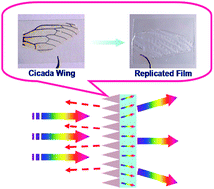Integration of antireflection and light diffraction in nature: a strategy for light trapping†
Abstract
The replication of an entire cicada wing was conducted by using a low-surface-energy florin

* Corresponding authors
a
Department of Chemistry, Renmin University of China, Beijing 100872, China
E-mail:
yapeiwang@ruc.edu.cn
b Institute of Chemistry, Chinese Academy of Sciences, Beijing 100190, China
c College of Chemistry and Molecular Engineering, Peking University, Beijing 100871, China
The replication of an entire cicada wing was conducted by using a low-surface-energy florin

 Please wait while we load your content...
Something went wrong. Try again?
Please wait while we load your content...
Something went wrong. Try again?
X. Zhang, D. Ji, T. Lei, B. Zhao, K. Song, W. Hu, J. Wang, J. Pei and Y. Wang, J. Mater. Chem. A, 2013, 1, 10607 DOI: 10.1039/C3TA11738C
To request permission to reproduce material from this article, please go to the Copyright Clearance Center request page.
If you are an author contributing to an RSC publication, you do not need to request permission provided correct acknowledgement is given.
If you are the author of this article, you do not need to request permission to reproduce figures and diagrams provided correct acknowledgement is given. If you want to reproduce the whole article in a third-party publication (excluding your thesis/dissertation for which permission is not required) please go to the Copyright Clearance Center request page.
Read more about how to correctly acknowledge RSC content.
 Fetching data from CrossRef.
Fetching data from CrossRef.
This may take some time to load.
Loading related content
